I recently worked on a very unique client with my survey partner Mike Magyar of Magyar Surveying in Astoria. Our client owns a property in Cannon Beach, OR that has views west towards the Pacific Ocean. A nearby neighbor needed to raise their roof to meet proper building code but our client worried that the raised roof would obstruct much of the view of the ocean breakers to the west. The other option was to tear down the building instead and rebuild it according to newer city planning rules which allowed for an even taller roof. This was a perfect opportunity to use a survey-grade 3D model created from aerial imagery to conduct a legit viewshed analysis as viewed from the deck of our client’s home. Our job was to not only qualify with imagery but also to quantify with numbers the different amount of obstruction in each scenario.

Mike and I both met up at the property on August 31st. Mike and I had sketched out 16 painted air targets for the project which he wasted no time surveying while I prepped the drone and checked camera settings and flight plans. About an hour and half and 1400+ photos later we were packing up and on our way for a seafood snack at the Ecola Seafoods Market. Acquisition had gone wonderfully. There was an early morning layer of fog which prevented deep shadows and I was able to capture plenty of imagery with a ton of overlap for the model before the sun came out.

Over the next week I ran the data set through Pix4D both on my desktop and in the cloud as a backup at max settings to ensure I would have the highest resolution point cloud possible for the viewshed analysis. I had acquired just about 5 acres of imagery, capturing the entire length of Orford Street down to and on to the beach. I had flown at about 80ft and my average pixel resolution of the final orthomosaic was about 0.72cm/0.26in. I had used 10 of the aerial targets spread uniformly about the project AOI for georeferencing and set another 6 aside for accuracy assessment afterwards. After processing overnight and cleaning of noise from the point cloud I came out with roughly half an inch accuracy in the horizontal plane and about 2/3 of an inch in Z for vertical accuracy. This was an incredibly accurate 3D model for an entire neighborhood! The point cloud was 5gb and over 167 million points.


Analysis of the model was conducted in a CAD environment to create each potential scenario and quantification of obstruction was done in combination with scenerio proposals exported into professional photo editing software to quantify the blue ocean pixels in the distance. Of course this wasn’t as easy as it sounds here but I’m not going to post all my secrets 🙂 In the end we were able to qunatify for our client exactly how much view would be ostructed in for each scenario by a percentage obstructed compared to the current state. This is a methodology that I plan to write up more thoroughly and use on future projects for clients along the Oregon and Washington Coastline where ocean views are held most sacred!


One thought on “Viewshed Analysis”
Nice model. From the screen shot it appears you are using Drone Deploy. I’ve been a but frustrated with that software at times. Other than the nadir photos, what types of additional oblique shots did you take and were the from the same altitude as the nadirs? It seems there’s a law of diminishing returns.
Comments are closed.